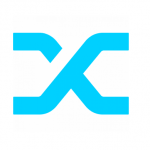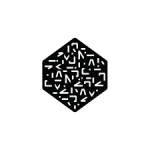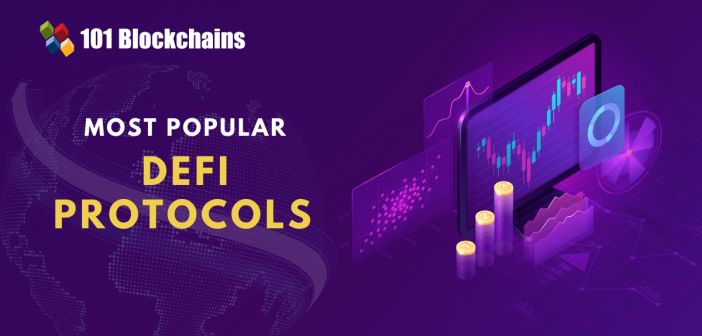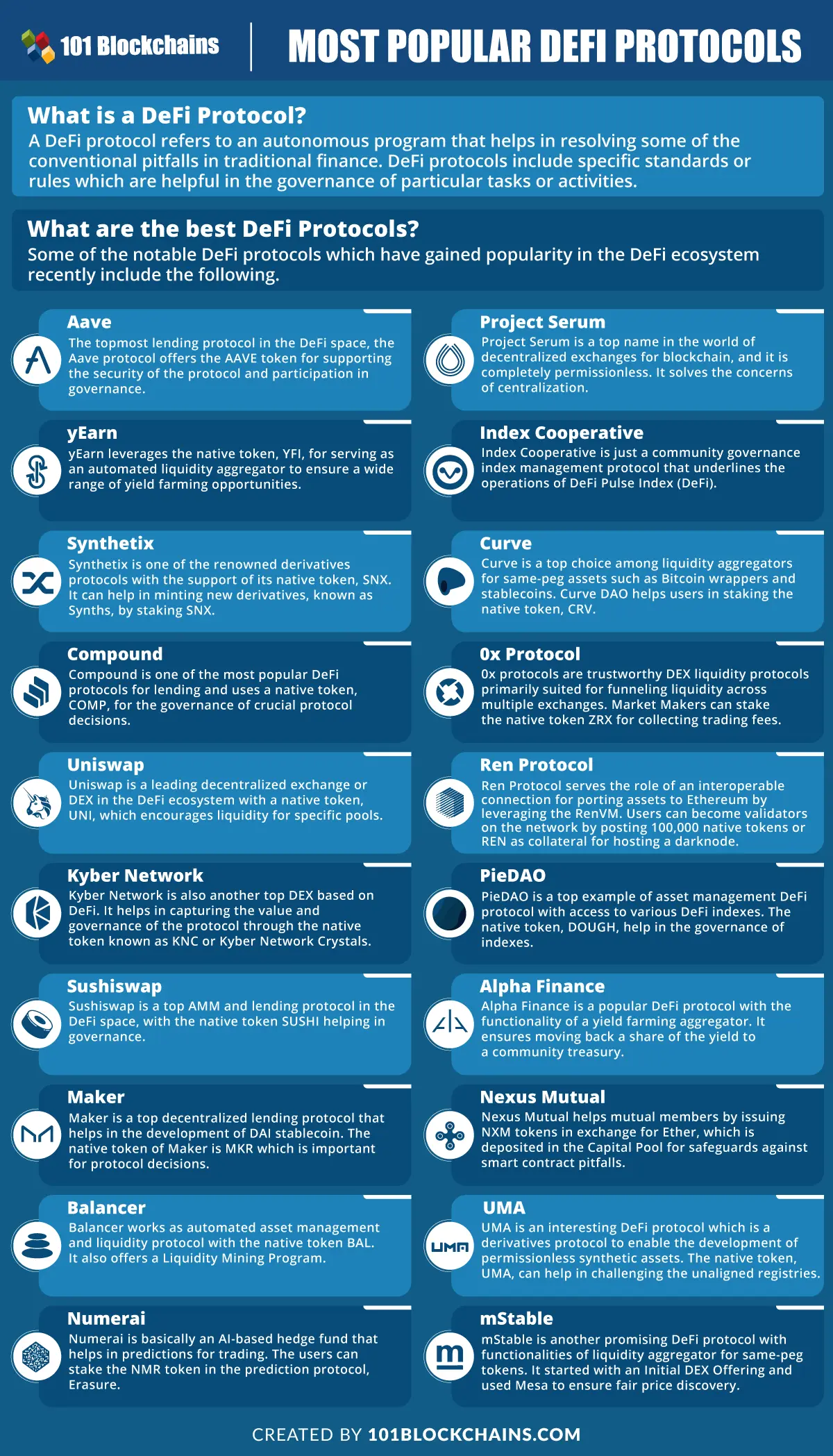The initial days of blockchain-focused excessively on the community and its associated capabilities for developing blockchain networks. However, the arrival of Ethereum changed the blockchain game considerably by opening up many possibilities for developing decentralized applications. The tokenization and smart contract functionalities in Ethereum spurred conversations regarding the next course of action for traditional finance.
Blockchain is one of the prominent disruptive technologies for the financial sector in recent times. With a completely different wave of financial innovation, the world witnessed the rise of DeFi, and top DeFi protocols started gaining attention. So, what is DeFi, and what are DeFi protocols? Why are they so popular? The following discussion helps you find out plausible answers to these questions. Most important of all, you can find an illustration of the most popular DeFi protocols with brief descriptions.
Want to learn and understand the scope and purpose of DeFi? Enroll Now in Introduction to DeFi- Decentralized Finance Course
What is DeFi?
The definition of decentralized finance is the most basic information you need to understand DeFi protocols. Decentralized Finance, or DeFi, basically points out the transition from conventional, centralized financial systems towards a peer-to-peer finance model. The DeFi ecosystem has been successful in establishing lending and borrowing platforms alongside tokenized digital currency and stablecoins. Over the course of time, the DeFi landscape has developed into a massive network with integrated financial instruments and protocols. Did someone read ‘protocol’?
Want to explore in-depth about DeFi protocol and its use cases? Join the Standard & Premium Plans and get free access to Decentralized Finance (Defi) Course- Intermediate Level Now!
What are DeFi Protocols?
The best DeFi protocols have witnessed profound levels of growth in the recent two years. The year 2020 proved to be quite a promising one for DeFi as the total value locked in DeFi assets crossed the $12 billion mark. DeFi protocols are basically autonomous programs that have been tailored for addressing specific setbacks in the traditional finance sector. More than half of the world’s population does not have access to a bank account, and DeFi protocols aim to change it.
The evolution of DeFi protocols will open the way for introducing more financial instruments. As of now, many DeFi protocols have become integral parts of a complex ecosystem with many notable tokens and projects. With the substantially soaring values of DeFi protocols, the opportunities for startups in the DeFi space become clearly evident.
Importance of DeFi Protocols
Before reflecting on a DeFi protocols list, it is important for you to understand DeFi protocols on a technical level. Protocols can be considered as the rules or standards written for governing particular tasks or activities. DeFi protocols can feature a collection of rules and principles in alignment with real-world institutions for participants in specific industries.
The participants must consider the protocols as essential prerequisites for operating in DeFi ecosystem. Most important of all, DeFi protocols offer liquidity in the DeFi ecosystem while also ensuring interoperability. As a result, multiple entities could use the most popular DeFi protocols for building an app or service.
Want to explore an in-depth understanding of security threats in DeFi projects? Join the Standard & Premium Plans and get free access to DeFi Security Fundamentals Course Now!
What are the Best DeFi Protocols?
Please include attribution to 101blockchains.com with this graphic. <a href='https://101blockchains.com/blockchain-infographics/'> <img src='https://101blockchains.com/wp-content/uploads/2021/08/Most-Popular-Defi-Protocols-2.png' alt='top defi protocols='0' /> </a>
As of February 2021, the total value locked in the assets of the DeFi ecosystem amounted to a staggering $40 billion. This is obviously one of the first reasons for finding out more about the top DeFi protocols and their functionalities. DeFi protocols are tailored for various use cases in the financial sector, primarily for borrowing and lending applications. At the same time, it is also important to note that the DeFi ecosystem is still under development, and many of the projects have prominent risk factors. Let us dive right into a DeFi protocols list that can help you learn more about the world of DeFi.
1. Aave

Aave is one of the most popular and leading lending protocols in the DeFi landscape. It utilizes the native token AAVE for the security of the protocol alongside enabling users to participate in the governance of the protocol. Users can stake AAVE tokens through the Safety Module for achieving AAVE rewards.
2. yEarn

yEarn is also a top mention among the best DeFi protocols. It is actually an automated liquidity aggregator with the facility of a wide range of opportunities for yield farming. The native token of yEarn, YFI, is responsible for the governance of the protocol. Users could stake YFI tokens for participating in the governance of the protocol alongside claiming a pro-rata share from protocol fees.
Start learning Decentralized Finance (DeFi) with World’s first DeFi Skill Path with quality resources tailored by industry experts Now!
3. Synthetix

The next significant entry among the top DeFi protocols in this list would refer to Synthetix. It is one of the prominent derivatives protocols with its own native token, known as SNX. Users have to stake at least 750% of the value of new derivatives to be minted, known as Synths, with SNX tokens. The ratio is known as cRatio and helps users in earning native inflation alongside a share of trading fees.
4. Compound

It is quite impossible to develop a list of DeFi protocols without the name of Compound, the leading lending protocol. The protocol features a native token, known as COMP, which users can earn by lending or borrowing assets. COMP is also helpful for the governance of important protocol decisions with the flexibility of voting and delegation through the Compound Governance Dashboard.
Learn the fundamentals of Decentralized Finance (DeFi) with DeFi flashcards!
5. Uniswap

Uniswap is also another prominent entry among the biggest DeFi protocols in present times. It is presently the topmost decentralized exchange in the DeFi space. Users can earn the native token, UNI, by offering liquidity to particular pools. In September 2020, Uniswap offered 15% of its supply to previous users by introducing a program, “Universal Basic Income.”
6. Kyber Network

The Kyber Network is also another promising example among top decentralized exchanges or DEXs, with capabilities for capturing value through native tokens. The native tokens on Kyber Network are known as Kyber Network Crystals or KNC. Users can leverage KNC tokens in their ownership for gaining the ability for voting and delegate on crucial decisions such as the introduction of key governance mechanisms.
Join the Standard & Premium Plans now to watch our on-demand webinar on DeFi And The Future Of Finance
7. Sushiswap

Sushiswap is an Automated Market Maker (AMM) and lending protocol with a governance token known as SUSHI. Liquidity providers can earn the SUSHI token by offering liquidity to chosen pairs on Sushiswap. Users could stake SUSHI tokens by using the Omaske bar for earning protocol fees and issuing protocols.
8. Maker

The next top addition in the DeFi protocols list would obviously bring Maker into the equation. Maker is one of the renowned decentralized lending protocols. The striking highlight of the Maker DeFi protocol is its role in creating DAI. The native token of Maker, MKR, can help in voting on protocol decisions by using the Maker voting dashboard.
Build your identity as a certified blockchain expert with 101 Blockchains’ Blockchain Certifications designed to provide enhanced career prospects
9. Balancer

Balancer also accounts for one of the significantly unique mentions among most popular DeFi protocols in present times. The Balancer DeFi protocol focuses on automated asset management and liquidity with the facility of governance through the native token. The native token, BAL, helps in the governance of crucial protocol aspects such as support assets and protocol fees.
10. Numerai

Numerai also qualifies as one of the entries in the list of renowned DeFi protocols. It is an AI-based hedge fund that creates the Erasure protocol, which can help in predictions. Users could leverage the stakes of NMR tokens in the prediction protocol for showcasing their confidence in the predictions.
Start your blockchain journey Now with the Enterprise Blockchains Fundamentals – Free Course!
11. Project Serum

Project Serum is also easily one of the biggest DeFi protocols in present times. It is the most recent addition to the world of DEXs or decentralized exchanges. The unique highlights of Project Serum refer to the fact that it is completely permissionless and has not been developed on Ethereum.
12. Index Cooperative

The Index Cooperative DeFi protocol serves as a community governance index management protocol underlying the DeFi Pulse Index or DPI. The native INDEX governance token helps in determining the content of indexes. It also helps in determining the approaches for using the indexes in meta-governance for associated protocols.
Excited to learn the basic and advanced concepts of ethereum technology? Enroll Now in The Complete Ethereum Technology Course
13. Curve

Curve is another prominent addition among the top DeFi protocols in present times. It is practically a liquidity aggregator for same-peg assets such as Bitcoin wrappers and stablecoins. Users can stake the native token of Curve protocol, CRV, through the Curve DAO for achieving efficient time-weighted governance. In addition, users can also earn liquidity multipliers for CRV liquidity mining.
14. 0x Protocol

The list of best DeFi protocols would also turn the limelight towards 0x protocol for its unique functionalities. It is a DeFi liquidity protocol that can help in funneling liquidity across various types of exchanges. The native token, ZRX, could help users in the governance of the protocol. Additionally, Market Makers can also stake ZRX for obtaining trading fees.
Want to become a bitcoin expert? Enroll Now in Getting Started with Bitcoin Technology Course
15. Ren Protocol

Another top entry among the renowned DeFi protocols in present times is Ren Protocol. It serves as an interoperable connection for moving assets to Ethereum. Users can qualify as validators on the network by posing 100,000 REN in the form of collateral for hosting dark nodes.
16. PieDAO

You would also find PieDAO among the top DeFi protocols with promising potential. PieDAO serves the function of asset management with the value of automation alongside accessibility for various DeFi indexes. Interestingly, you can find many liquidity mining programs currently for earning DOUGH, the native token of PieDAO.
Want to learn the basic and advanced concepts of Ethereum? Enroll in our Ethereum Development Fundamentals Course right away!
17. Alpha Finance

Alpha Finance is also another promising addition among DeFi protocols with innovative functionalities. It actually serves as a yield-farming aggregator for Alpha Homora, which is a product for lending idle ETH for farming on leverage. The most striking highlight in Alpha Finance refers to the redirection of a portion of the yield to the community treasury.
18. Nexus Mutual

Nexus Mutual is a DeFi platform for issuing NXM to mutual members in exchange for ETH deposited in the Capital Pool. It can help in offering ideal safeguards against smart contract vulnerabilities. Members have the flexibility of staking on different contracts for collecting a specific share of fees earned through cover purchases. Nexus Mutual also plans on introducing pooled staking for enabling the allocation of all purchased covers to users staking their NXM tokens.
Get familiar with the terms related to ethereum with Ethereum Flashcards
19. UMA

The DeFi protocols list could also include UMA as another protocol with innovative potential. As a derivatives protocol, UMA enables the development of permissionless synthetic assets. The native token, also known as UMA, helps in the governance of protocol decisions alongside challenging underlying registries which are not aligned with related synthetic assets.
20. mStable

Another promising example of liquidity aggregators among DeFi protocols is mstable. It has been tailored for same-peg tokens referred to as mASSETS or mUSD. The native token of the protocol, MTA, started with an Initial DEX Offering, and users can stake MTA through the Earn feature. Staking the MTA token could help in earning claims on protocol fees alongside MTA inflation.
Learn the fundamentals of Decentralized Finance (DeFi) with DeFi flashcards!
Final Words
On a final note, it is quite clear that the massive ecosystem of best DeFi protocols would continue to expand. You have decentralized exchanges (DEXs), liquidity aggregators, and margin trading platforms, asset management platforms, and lending platforms with DeFi protocols. With such a varied range of use cases in the financial sector, DeFi protocols are truly revolutionizing traditional financial sector norms.
However, it is also important to be cautious about the progress of DeFi protocols. There is no doubt that you are getting new DeFi projects in the news every day. On the other hand, it is also important to find the possible areas where DeFi protocols might fall out of line. DeFi protocols have their own share of risks and flaws, such as a lack of decentralization.
Learn more about decentralized finance and discover more about DeFi protocols now with the DeFi course!
*Disclaimer: The article should not be taken as, and is not intended to provide any investment advice. Claims made in this article do not constitute investment advice and should not be taken as such. 101 Blockchains shall not be responsible for any loss sustained by any person who relies on this article. Do your own research!







